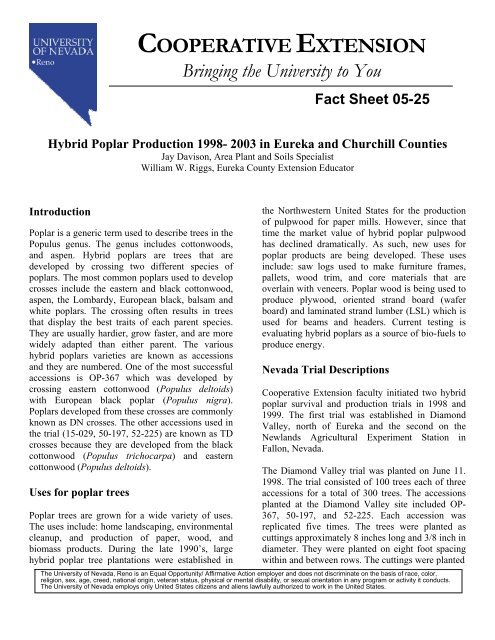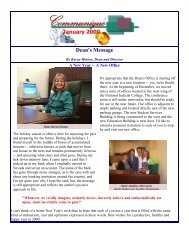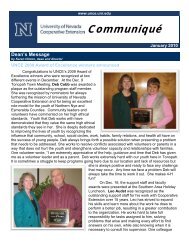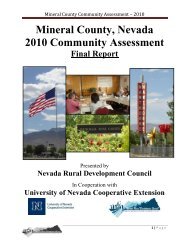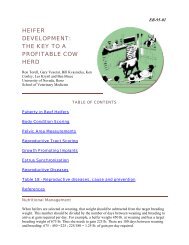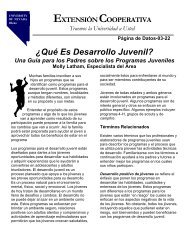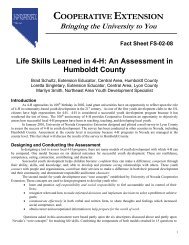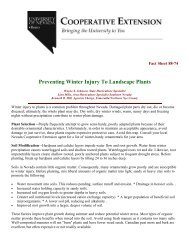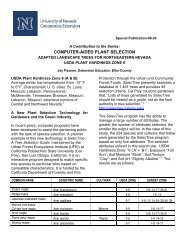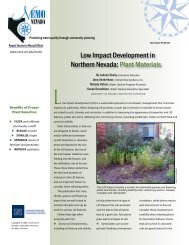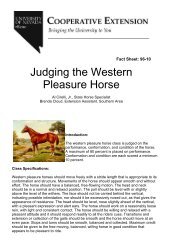Hybrid Poplar Production 1998 - University of Nevada Cooperative ...
Hybrid Poplar Production 1998 - University of Nevada Cooperative ...
Hybrid Poplar Production 1998 - University of Nevada Cooperative ...
Create successful ePaper yourself
Turn your PDF publications into a flip-book with our unique Google optimized e-Paper software.
COOPERATIVE EXTENSION<br />
Bringing the <strong>University</strong> to You<br />
Fact Sheet 05-25<br />
<strong>Hybrid</strong> <strong>Poplar</strong> <strong>Production</strong> <strong>1998</strong>- 2003 in Eureka and Churchill Counties<br />
Jay Davison, Area Plant and Soils Specialist<br />
William W. Riggs, Eureka County Extension Educator<br />
Introduction<br />
<strong>Poplar</strong> is a generic term used to describe trees in the<br />
Populus genus. The genus includes cottonwoods,<br />
and aspen. <strong>Hybrid</strong> poplars are trees that are<br />
developed by crossing two different species <strong>of</strong><br />
poplars. The most common poplars used to develop<br />
crosses include the eastern and black cottonwood,<br />
aspen, the Lombardy, European black, balsam and<br />
white poplars. The crossing <strong>of</strong>ten results in trees<br />
that display the best traits <strong>of</strong> each parent species.<br />
They are usually hardier, grow faster, and are more<br />
widely adapted than either parent. The various<br />
hybrid poplars varieties are known as accessions<br />
and they are numbered. One <strong>of</strong> the most successful<br />
accessions is OP-367 which was developed by<br />
crossing eastern cottonwood (Populus deltoids)<br />
with European black poplar (Populus nigra).<br />
<strong>Poplar</strong>s developed from these crosses are commonly<br />
known as DN crosses. The other accessions used in<br />
the trial (15-029, 50-197, 52-225) are known as TD<br />
crosses because they are developed from the black<br />
cottonwood (Populus trichocarpa) and eastern<br />
cottonwood (Populus deltoids).<br />
Uses for poplar trees<br />
<strong>Poplar</strong> trees are grown for a wide variety <strong>of</strong> uses.<br />
The uses include: home landscaping, environmental<br />
cleanup, and production <strong>of</strong> paper, wood, and<br />
biomass products. During the late 1990’s, large<br />
hybrid poplar tree plantations were established in<br />
the Northwestern United States for the production<br />
<strong>of</strong> pulpwood for paper mills. However, since that<br />
time the market value <strong>of</strong> hybrid poplar pulpwood<br />
has declined dramatically. As such, new uses for<br />
poplar products are being developed. These uses<br />
include: saw logs used to make furniture frames,<br />
pallets, wood trim, and core materials that are<br />
overlain with veneers. <strong>Poplar</strong> wood is being used to<br />
produce plywood, oriented strand board (wafer<br />
board) and laminated strand lumber (LSL) which is<br />
used for beams and headers. Current testing is<br />
evaluating hybrid poplars as a source <strong>of</strong> bio-fuels to<br />
produce energy.<br />
<strong>Nevada</strong> Trial Descriptions<br />
<strong>Cooperative</strong> Extension faculty initiated two hybrid<br />
poplar survival and production trials in <strong>1998</strong> and<br />
1999. The first trial was established in Diamond<br />
Valley, north <strong>of</strong> Eureka and the second on the<br />
Newlands Agricultural Experiment Station in<br />
Fallon, <strong>Nevada</strong>.<br />
The Diamond Valley trial was planted on June 11.<br />
<strong>1998</strong>. The trial consisted <strong>of</strong> 100 trees each <strong>of</strong> three<br />
accessions for a total <strong>of</strong> 300 trees. The accessions<br />
planted at the Diamond Valley site included OP-<br />
367, 50-197, and 52-225. Each accession was<br />
replicated five times. The trees were planted as<br />
cuttings approximately 8 inches long and 3/8 inch in<br />
diameter. They were planted on eight foot spacing<br />
within and between rows. The cuttings were planted<br />
The <strong>University</strong> <strong>of</strong> <strong>Nevada</strong>, Reno is an Equal Opportunity/ Affirmative Action employer and does not discriminate on the basis <strong>of</strong> race, color,<br />
religion, sex, age, creed, national origin, veteran status, physical or mental disability, or sexual orientation in any program or activity it conducts.<br />
The <strong>University</strong> <strong>of</strong> <strong>Nevada</strong> employs only United States citizens and aliens lawfully authorized to work in the United States.
with one bud showing above the soil line and all<br />
buds facing up. They were irrigated using drip<br />
irrigation. The trees were protected from grazing<br />
deer by 48” tall growth tubes. An active<br />
fertilization, weed and rodent control program was<br />
established at the same time to maximize growth <strong>of</strong><br />
the trees.<br />
The Fallon trial was established on April 27, 1999<br />
with the planting <strong>of</strong> 294 (98 each accession) trees.<br />
The accessions planted in Fallon included OP-367,<br />
50-197, and 15-029. The trees were planted on five<br />
foot spacing within and between rows. Each<br />
accession was replicated seven times. They were<br />
planted in the same fashion as the Diamond Valley<br />
trial. The Fallon trees were irrigated using flood<br />
irrigation on the same schedule as the adjacent<br />
alfalfa (approximately every 2 weeks). Weeds were<br />
controlled using Roundup® and mechanical<br />
methods. No fertilizer was applied. In April <strong>of</strong><br />
2002, ten trees <strong>of</strong> each accession were dug using a<br />
24” tree spade and moved approximately 100 yards<br />
to test the ability <strong>of</strong> the trees to withstand<br />
transplanting as potential landscape stock.<br />
The trees were thinned by removing every other tree<br />
April <strong>of</strong> 2003. The purpose <strong>of</strong> the removal was to<br />
increase the tree spacing and determine biomass<br />
production after four years. The total green weight<br />
<strong>of</strong> each accession was recorded during the thinning<br />
process.<br />
Results -Diamond Valley Trial<br />
The planting costs for each tree on the Diamond<br />
Valley site are displayed in table 1.<br />
Table 1. Cash costs per hybrid poplar trees planted<br />
in Diamond Valley, <strong>Nevada</strong> on June 11, <strong>1998</strong>.<br />
Input<br />
Cost<br />
Trees $0.20<br />
Tree shelter & stakes $3.16<br />
Drip irrigation $2.00<br />
Labor $2.10<br />
Total cash cost/tree $7.46<br />
The trees begin budding on June 25, <strong>1998</strong>, and by<br />
the end <strong>of</strong> July, the trees were beginning to grow<br />
out <strong>of</strong> the tops <strong>of</strong> the tree shelters that were 4 feet in<br />
height. The irrigation to the trees was reduced by<br />
approximately 50 percent beginning the first <strong>of</strong><br />
September in an attempt to “harden <strong>of</strong>f” the trees<br />
for winter. The first killing frost occurred on<br />
September 19 th when the temperatures dipped to 27<br />
degrees Fahrenheit. The irrigation system was then<br />
shut down to avoid damage to the system. The<br />
survival and production evaluation was completed<br />
on October 12, <strong>1998</strong>. The survival percentage was<br />
in excess <strong>of</strong> 99% with only two trees failing to grow<br />
out <strong>of</strong> the 300 planted.<br />
The production evaluation was limited to<br />
determining the average tree heights at the end <strong>of</strong><br />
the first growing season. Table 2 is the average tree<br />
height <strong>of</strong> the three hybrid poplar accessions planted<br />
in Diamond Valley during June <strong>1998</strong> and measured<br />
during October <strong>1998</strong>.<br />
Table 2. Average first year tree heights <strong>of</strong> three<br />
hybrid poplar accessions planted in Diamond Valley<br />
in <strong>1998</strong>.<br />
Accession<br />
Ave. Tree Heights<br />
(ft)<br />
OP-367 4.5<br />
50-197 4.4<br />
52-225 4.5<br />
Irrigation <strong>of</strong> the trees planted in Diamond valley<br />
resumed in May <strong>of</strong> 1999. The vast majority <strong>of</strong> the<br />
top growth <strong>of</strong> the trees winterkilled. By the October<br />
1999 evaluation, most <strong>of</strong> the trees had sprouted<br />
from the roots but were considered a loss. The<br />
project was abandoned that year.<br />
Results-Fallon Trial<br />
The planting costs for the Fallon trial were much<br />
lower than that experienced in Diamond valley. No<br />
tree shelters or drip irrigation supplies were<br />
required as the trees were flood irrigated and no<br />
deer were present. The planting technique was also<br />
less labor intensive as the only action required was<br />
to press a 3/8” hole in the soil and press the cutting<br />
into the hole. Table 3 is the estimated cash cost <strong>of</strong><br />
planting hybrid poplars in Fallon
Table 3. Cash cost per hybrid poplar tree planted in<br />
Fallon, <strong>Nevada</strong> on April 27, 1999.<br />
Input<br />
Cost<br />
Trees $0.20<br />
Labor $0.50<br />
Total cash cost/tree $0.70<br />
The trees were evaluated for survival and<br />
production in November <strong>of</strong> 1999. The information<br />
collected included the number alive, and the height.<br />
Table 4 displays the results <strong>of</strong> the first year<br />
evaluations.<br />
Table 4. Average first year survival percentage, and<br />
tree height for three hybrid poplar accessions<br />
planted in 1999 in Fallon, <strong>Nevada</strong>.<br />
Accession Survival<br />
(%)<br />
Tree ht.<br />
(feet)<br />
OP-367 100 4.4<br />
50-197 99 4.0<br />
15-029 94 4.6<br />
The trees fared well in the winter <strong>of</strong> 1999-2000 with<br />
only 1 additional death and rapid growth occurring<br />
with all accessions. Table 5 displays the evaluation<br />
information collected for the 2000 growing season.<br />
Table 5. Average two-year survival percentage, tree<br />
height, three hybrid poplar accessions planted in<br />
1999 Fallon, <strong>Nevada</strong>.<br />
Accession Survival (%) Tree ht. (feet)<br />
OP-367 100 12.3<br />
50-197 99 11.0<br />
15-029 93 11.8<br />
Tree survival continued to be excellent over the<br />
winter <strong>of</strong> 2000-2001 with only one additional death.<br />
By the fall <strong>of</strong> 2001, the trees were large enough to<br />
begin collecting data on tree diameters one foot<br />
above the ground. Table 6 displays the evaluation<br />
information collected for the 2001 growing season.<br />
Table 6. Average three-year survival percentage,<br />
tree height, and diameter for three hybrid poplar<br />
accessions planted in 1999 in Fallon, <strong>Nevada</strong>.<br />
Accession Survival (%) Tree ht<br />
(feet)<br />
Tree diam.<br />
(inch)<br />
OP-367 100 26.1 2.9<br />
50-197 99 20.8 2.5<br />
15-029 93 19.2 2.0<br />
Tree survival, heights and diameters were again<br />
recorded following the 2002 growing season. No<br />
additional trees had winterkilled and the growth rate<br />
continued to be exceptional. Table 7 presents the<br />
results <strong>of</strong> the 2002 growing season.<br />
Table 7. Average four-year survival percentage, tree<br />
height, and diameter for three hybrid poplar<br />
accessions planted in 1999 in Fallon, <strong>Nevada</strong>.<br />
Accession Survival<br />
(%)<br />
Tree ht<br />
(feet)<br />
Tree diam.<br />
(inch)<br />
OP-367 100 37.2 4.2<br />
50-197 99 28.5 3.4<br />
15-029 93 26.7 2.8<br />
The greenwood biomass from each accession was<br />
determined in April <strong>of</strong> 2003 by cutting and<br />
weighing every other tree in the plantation. The<br />
data was converted to average weight per tree<br />
(green weight) in order to calculate different<br />
yields/acre based on tree spacing. Table 8 is the<br />
average tree weight from the 4-year-old stand<br />
growing in Fallon and tons per acre dry weight on 5<br />
X 5 spacing. The moisture percentage <strong>of</strong> the<br />
harvested trees is assumed to be 50%.<br />
Table 8. Average hybrid poplar biomass production<br />
after 4 years by tree and per acre with 5’ X 5’<br />
spacing, assuming 50% moisture content <strong>of</strong> the<br />
harvested trees.<br />
Accession<br />
Ave.<br />
lbs/tree<br />
(green wt)<br />
Ave.<br />
tons/acre<br />
(dry wt)<br />
OP-367 63.1 27.4<br />
50-197 44.9 19.5<br />
15-029 47.9 20.8
Discussion<br />
The hybrid poplar trees planted in Eureka were a<br />
complete failure as over 98% died the first winter.<br />
<strong>Hybrid</strong> poplars are grown in climates colder than<br />
Eureka throughout the United States and the authors<br />
speculate that the tree shelters remained on the trees<br />
too long and were irrigated too late in the season<br />
which delayed the onset <strong>of</strong> dormancy. Because <strong>of</strong><br />
the abnormal warmth, provided by the shelters the<br />
trees failed to go dormant before winter<br />
temperatures dropped into the killing range. The<br />
trial was not repeated.<br />
The Fallon trial was much more successful with<br />
four-year mortality ranging from a low <strong>of</strong> 0 percent<br />
to a high <strong>of</strong> only 7 percent. The accession OP-367<br />
averaged 9.3 feet <strong>of</strong> growth per year, while 50-197<br />
and 15-029 grew at 7.1 and 6.7 feet per year<br />
respectively. The growth in diameter was less<br />
impressive due to competition for light and space<br />
resulting from the 5’ by 5’ spacing.<br />
Resources used to develop this fact sheet<br />
Blatner, K. A., Johnson, J.D. and Baumgartner, D.<br />
M. (Eds), 2000, <strong>Hybrid</strong> <strong>Poplar</strong>s in the Pacific<br />
Northwest: Culture, Commerce, and Capability.<br />
Symp. Proc. <strong>Cooperative</strong> Extension, Washington<br />
State <strong>University</strong>. Pullman, Washington.<br />
Bowersox, T.W., Blankenhorn, P.R., and Murphy,<br />
W.K. 1979. Heat <strong>of</strong> combustion, ash content,<br />
nutrient content, and chemical content, <strong>of</strong> populus<br />
hybrids. Wood Science. 11:257-262.<br />
Leavengood, S. and Reeb, J. 1997. Product and<br />
Marketing Opportunities for <strong>Hybrid</strong> <strong>Poplar</strong> Wood in<br />
Oregon. EM 8667. Oregon State <strong>University</strong><br />
Extension Service. Corvallis, Oregon<br />
Mater Engineering. <strong>1998</strong>. Marketing Study for a<br />
Multi-Region Plantation <strong>Hybrid</strong> <strong>Poplar</strong> Project.<br />
Mater Engineering Ltd. Corvallis, Oregon<br />
The biomass produced by the trees was comparable<br />
to that experienced by hybrid poplar trees growing<br />
in the Northwest. Accession OP-367 averaged 6.8<br />
tons per acre per year. Accession 50-197 and 15-<br />
029 averaged 4.8 and 5.2 tons per acre per year over<br />
the four-year growth period.<br />
The hybrid poplar trial is continuing in Fallon.<br />
Results will be updated as the data is developed.


